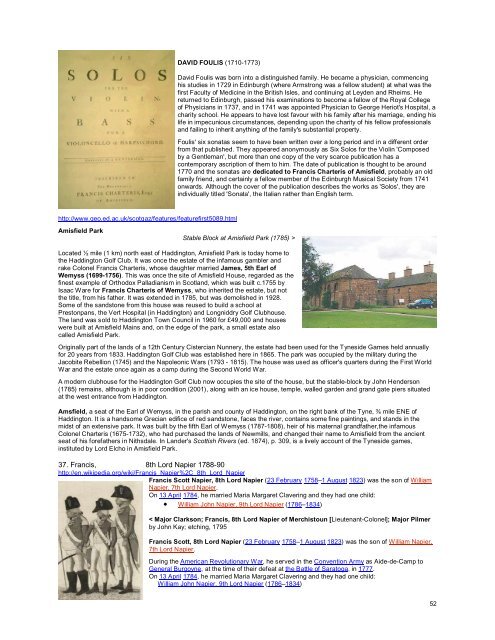Grand Masters of Scotland - Onondaga and Oswego Masonic ...
Grand Masters of Scotland - Onondaga and Oswego Masonic ...
Grand Masters of Scotland - Onondaga and Oswego Masonic ...
Create successful ePaper yourself
Turn your PDF publications into a flip-book with our unique Google optimized e-Paper software.
DAVID FOULIS (1710-1773)<br />
David Foulis was born into a distinguished family. He became a physician, commencing<br />
his studies in 1729 in Edinburgh (where Armstrong was a fellow student) at what was the<br />
first Faculty <strong>of</strong> Medicine in the British Isles, <strong>and</strong> continuing at Leyden <strong>and</strong> Rheims. He<br />
returned to Edinburgh, passed his examinations to become a fellow <strong>of</strong> the Royal College<br />
<strong>of</strong> Physicians in 1737, <strong>and</strong> in 1741 was appointed Physician to George Heriot's Hospital, a<br />
charity school. He appears to have lost favour with his family after his marriage, ending his<br />
life in impecunious circumstances, depending upon the charity <strong>of</strong> his fellow pr<strong>of</strong>essionals<br />
<strong>and</strong> failing to inherit anything <strong>of</strong> the family's substantial property.<br />
Foulis' six sonatas seem to have been written over a long period <strong>and</strong> in a different order<br />
from that published. They appeared anonymously as Six Solos for the Violin 'Composed<br />
by a Gentleman', but more than one copy <strong>of</strong> the very scarce publication has a<br />
contemporary ascription <strong>of</strong> them to him. The date <strong>of</strong> publication is thought to be around<br />
1770 <strong>and</strong> the sonatas are dedicated to Francis Charteris <strong>of</strong> Amisfield, probably an old<br />
family friend, <strong>and</strong> certainly a fellow member <strong>of</strong> the Edinburgh Musical Society from 1741<br />
onwards. Although the cover <strong>of</strong> the publication describes the works as 'Solos', they are<br />
individually titled 'Sonata', the Italian rather than English term.<br />
http://www.geo.ed.ac.uk/scotgaz/features/featurefirst5089.html<br />
Amisfield Park<br />
Stable Block at Amisfield Park (1785) ><br />
Located ½ mile (1 km) north east <strong>of</strong> Haddington, Amisfield Park is today home to<br />
the Haddington Golf Club. It was once the estate <strong>of</strong> the infamous gambler <strong>and</strong><br />
rake Colonel Francis Charteris, whose daughter married James, 5th Earl <strong>of</strong><br />
Wemyss (1699-1756). This was once the site <strong>of</strong> Amisfield House, regarded as the<br />
finest example <strong>of</strong> Orthodox Palladianism in <strong>Scotl<strong>and</strong></strong>, which was built c.1755 by<br />
Isaac Ware for Francis Charteris <strong>of</strong> Wemyss, who inherited the estate, but not<br />
the title, from his father. It was extended in 1785, but was demolished in 1928.<br />
Some <strong>of</strong> the s<strong>and</strong>stone from this house was reused to build a school at<br />
Prestonpans, the Vert Hospital (in Haddington) <strong>and</strong> Longniddry Golf Clubhouse.<br />
The l<strong>and</strong> was sold to Haddington Town Council in 1960 for £49,000 <strong>and</strong> houses<br />
were built at Amisfield Mains <strong>and</strong>, on the edge <strong>of</strong> the park, a small estate also<br />
called Amisfield Park.<br />
Originally part <strong>of</strong> the l<strong>and</strong>s <strong>of</strong> a 12th Century Cistercian Nunnery, the estate had been used for the Tyneside Games held annually<br />
for 20 years from 1833. Haddington Golf Club was established here in 1865. The park was occupied by the military during the<br />
Jacobite Rebellion (1745) <strong>and</strong> the Napoleonic Wars (1793 - 1815). The house was used as <strong>of</strong>ficer's quarters during the First World<br />
War <strong>and</strong> the estate once again as a camp during the Second World War.<br />
A modern clubhouse for the Haddington Golf Club now occupies the site <strong>of</strong> the house, but the stable-block by John Henderson<br />
(1785) remains, although is in poor condition (2001), along with an ice house, temple, walled garden <strong>and</strong> gr<strong>and</strong> gate piers situated<br />
at the west entrance from Haddington.<br />
Amsfield, a seat <strong>of</strong> the Earl <strong>of</strong> Wemyss, in the parish <strong>and</strong> county <strong>of</strong> Haddington, on the right bank <strong>of</strong> the Tyne, ¾ mile ENE <strong>of</strong><br />
Haddington. It is a h<strong>and</strong>some Grecian edifice <strong>of</strong> red s<strong>and</strong>stone, faces the river, contains some fine paintings, <strong>and</strong> st<strong>and</strong>s in the<br />
midst <strong>of</strong> an extensive park. It was built by the fifth Earl <strong>of</strong> Wemyss (1787-1808), heir <strong>of</strong> his maternal gr<strong>and</strong>father,the infamous<br />
Colonel Charteris (1675-1732), who had purchased the l<strong>and</strong>s <strong>of</strong> Newmills, <strong>and</strong> changed their name to Amisfield from the ancient<br />
seat <strong>of</strong> his forefathers in Nithsdale. In L<strong>and</strong>er's Scottish Rivers (ed. 1874), p. 309, is a lively account <strong>of</strong> the Tyneside games,<br />
instituted by Lord Elcho in Amisfield Park.<br />
37. Francis, 8th Lord Napier 1788-90<br />
http://en.wikipedia.org/wiki/Francis_Napier%2C_8th_Lord_Napier<br />
Francis Scott Napier, 8th Lord Napier (23 February 1758–1 August 1823) was the son <strong>of</strong> William<br />
Napier, 7th Lord Napier.<br />
On 13 April 1784, he married Maria Margaret Clavering <strong>and</strong> they had one child:<br />
• William John Napier, 9th Lord Napier (1786–1834)<br />
< Major Clarkson; Francis, 8th Lord Napier <strong>of</strong> Merchistoun [Lieutenant-Colonel]; Major Pilmer<br />
by John Kay; etching, 1795<br />
Francis Scott, 8th Lord Napier (23 February 1758–1 August 1823) was the son <strong>of</strong> William Napier,<br />
7th Lord Napier.<br />
During the American Revolutionary War, he served in the Convention Army as Aide-de-Camp to<br />
General Burgoyne, at the time <strong>of</strong> their defeat at the Battle <strong>of</strong> Saratoga, in 1777.<br />
On 13 April 1784, he married Maria Margaret Clavering <strong>and</strong> they had one child:<br />
William John Napier, 9th Lord Napier (1786–1834)<br />
52







![Richard [Nicholls] Harison / Harrison - Onondaga and Oswego ...](https://img.yumpu.com/24950065/1/190x245/richard-nicholls-harison-harrison-onondaga-and-oswego-.jpg?quality=85)

![Richard [Nicholls] Harison / Harrison - Onondaga and Oswego ...](https://img.yumpu.com/24950063/1/190x245/richard-nicholls-harison-harrison-onondaga-and-oswego-.jpg?quality=85)







